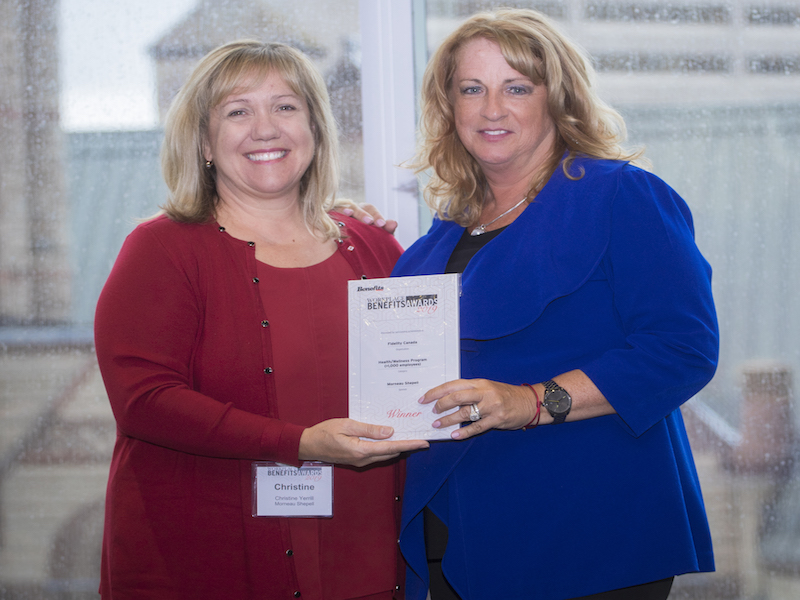
Fidelity Canada’s traditional health and wellness program has evolved into a holistic initiative that incorporates every aspect of working life, leading to its award win for a health and wellness program for an organization with more than 1,000 employees at Benefits Canada’s 2019 Workplace Benefits Awards in Toronto on Oct. 17.
“I think the reality is we’ve worked really hard to advance our health and wellness programs,” says Diana Godfrey, senior vice-president of human resources at Fidelity Canada. “We’re looking to do the things that are right for the organization — but more importantly, right for our employees. We listen to them and make changes based on their input and our ability to move forward.”
Read: Who are the winners of the 2019 Workplace Benefits Awards?
The organization’s mindfulness program, for example, includes a wide range of offerings such as an enhancement to psychologist coverage for full- and part-time employees, mindfulness training through its employee assistance program provider, online mindfulness training available through the company intranet, lunch and learn seminars, guided meditation and desk yoga.
As part of its investment in encouraging healthy eating habits, Fidelity Canada has continued its fruit basket initiative. Originally a charity fundraiser, where employees could purchase fruit from reception for a dollar, it has now become the most popular part of the company’s health and wellness program, providing fresh fruit to employees Monday through Friday.
“When the fundraising was over, employees asked where the basket was and said they’d continue to pay,” says Godfrey. “We said, ‘Better yet, you don’t need to pay. Here’s the fruit basket.’ It’s something everybody really appreciates and now we put baskets on all the different floors so it’s easily accessible for all employees.”
Over the last 12 months, Fidelity Canada also sponsored eight employee-driven sports teams — two men’s soccer teams, a co-ed volleyball team and five basketball teams taking part in the Bay Street Hoops tournament. “These experiences bring everyone closer together and, in the end, everyone learned that there’s no better way to bond with a colleague than to walk a mile in their running shoes,” said Amy Menachery, internal communications consultant at Fidelity Canada, in the award entry.
Read: Variety the spice of life for Niagara Casinos’ winning wellness program
The health and wellness program also offers activities to keep employees moving and motivated, including both indoor and outdoor walking meeting routes, adjustable workstations that allow employees to work seated or standing, as well as foosball and ping-pong tables in the break rooms that encourage physical activity and down time while fostering camaraderie among employees. “These are easy things to do that don’t cost a lot of money, but really are meaningful to the employees,” says Godfrey.
When employees set their minds to something, it happens, adds the award entry. Since the I [heart] D.E.B. program, in support of an employee who passed away, was created, it’s become an integral part of Fidelity Canada’s health and wellness focus. This is evidenced by the program’s intranet page, which contains more than 70 links to pertinent information, such as healthy workplace and self-care tips, mental-health resources and more.
Since the organization launched its telecommuting program in 2013, it’s seen a lot of movement. In 2018, this initiative expanded to five days a week with 200 employees telecommunicating across Toronto, Montreal and Vancouver. Today, that number has grown to 267. “We’re excited to embrace this change, become a stronger organization and innovate how we work and connect with our employees,” noted Menachery.
Read: What are the ingredients of a successful wellness program?
Fidelity Canada’s investment in health and wellness has shown a strong year-over-year return. Looking at participation alone, employees have continually demonstrated an interest in improving their personal and working lives, which heightens their perception of Fidelity Canada and its reputation, she added.
“We’re always looking for new ideas,” says Godfrey. “We’ve been speaking to our consultants about some of the different things we can do. We recognize that in the medical profession, it’s hard to find family practitioners, accessibility becomes an issue. So we are looking for ways to fill those voids.”
